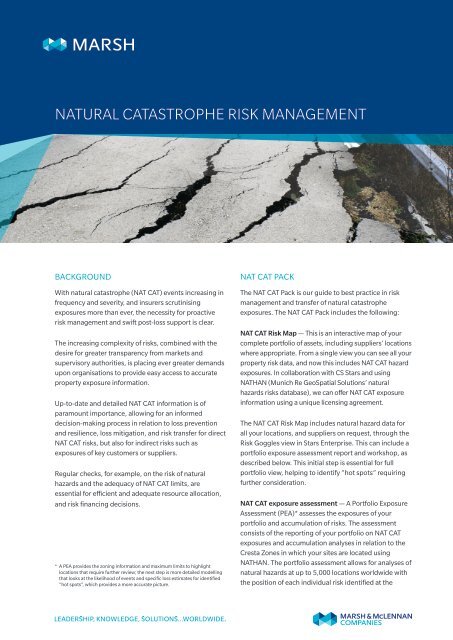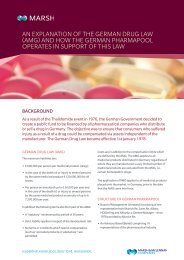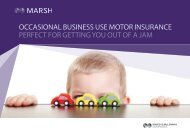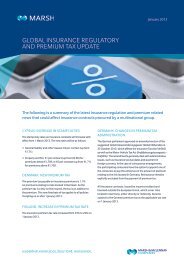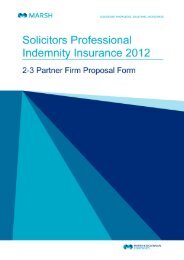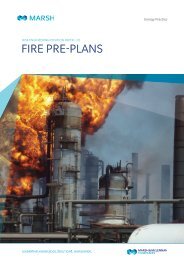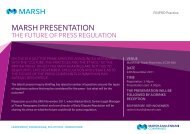Natural catastrophe risk management
Natural catastrophe risk maNagemeNt - Marsh
Natural catastrophe risk maNagemeNt - Marsh
Create successful ePaper yourself
Turn your PDF publications into a flip-book with our unique Google optimized e-Paper software.
<strong>Natural</strong> <strong>catastrophe</strong> <strong>risk</strong> <strong>management</strong>BackgroundWith natural <strong>catastrophe</strong> (NAT CAT) events increasing infrequency and severity, and insurers scrutinisingexposures more than ever, the necessity for proactive<strong>risk</strong> <strong>management</strong> and swift post-loss support is clear.The increasing complexity of <strong>risk</strong>s, combined with thedesire for greater transparency from markets andsupervisory authorities, is placing ever greater demandsupon organisations to provide easy access to accurateproperty exposure information.Up-to-date and detailed NAT CAT information is ofparamount importance, allowing for an informeddecision-making process in relation to loss preventionand resilience, loss mitigation, and <strong>risk</strong> transfer for directNAT CAT <strong>risk</strong>s, but also for indirect <strong>risk</strong>s such asexposures of key customers or suppliers.Regular checks, for example, on the <strong>risk</strong> of naturalhazards and the adequacy of NAT CAT limits, areessential for efficient and adequate resource allocation,and <strong>risk</strong> financing decisions.* A PEA provides the zoning information and maximum limits to highlightlocations that require further review; the next step is more detailed modellingthat looks at the likelihood of events and specific loss estimates for identified“hot spots”, which provides a more accurate picture.NAT CAT PackThe NAT CAT Pack is our guide to best practice in <strong>risk</strong><strong>management</strong> and transfer of natural <strong>catastrophe</strong>exposures. The NAT CAT Pack includes the following:NAT CAT Risk Map — This is an interactive map of yourcomplete portfolio of assets, including suppliers’ locationswhere appropriate. From a single view you can see all yourproperty <strong>risk</strong> data, and now this includes NAT CAT hazardexposures. In collaboration with CS Stars and usingNATHAN (Munich Re GeoSpatial Solutions’ naturalhazards <strong>risk</strong>s database), we can offer NAT CAT exposureinformation using a unique licensing agreement.The NAT CAT Risk Map includes natural hazard data forall your locations, and suppliers on request, through theRisk Goggles view in Stars Enterprise. This can include aportfolio exposure assessment report and workshop, asdescribed below. This initial step is essential for fullportfolio view, helping to identify “hot spots” requiringfurther consideration.NAT CAT exposure assessment — A Portfolio ExposureAssessment (PEA)* assesses the exposures of yourportfolio and accumulation of <strong>risk</strong>s. The assessmentconsists of the reporting of your portfolio on NAT CATexposures and accumulation analyses in relation to theCresta Zones in which your sites are located usingNATHAN. The portfolio assessment allows for analyses ofnatural hazards at up to 5,000 locations worldwide withthe position of each individual <strong>risk</strong> identified at the
maximum level of detail. This can include your ownlocations and that of suppliers, and can be extended to afull vulnerability and loss prevention assessment,providing information required for <strong>risk</strong> <strong>management</strong>,transfer, and NAT CAT modelling.NAT CAT modelling — Once the “hot spots” have beenidentified through the NAT CAT Risk Map and/or exposureassessment, detailed modelling is the next step. Marsh hasa team of global practitioners specialising in state-of-theartcomputer modelling techniques to analyse property<strong>risk</strong>s for multiple natural hazard perils in terms ofprobability of occurrence. This draws upon a worldwidedatabase of historical and probabilistic informationrelating to earthquakes, hurricanes, tornados, and hail.Knowing the 250-year or 500-year loss level and theaverage annual loss (AAL), combined with the exposureassessment and COPE data, will give you superiorknowledge of your <strong>risk</strong>s, strengthening your position inthe insurance marketplace.NAT CAT event scenario workshops — Bringing togetherexperts from all relevant areas of <strong>risk</strong> (property, businessinterruption, environmental, liability), we offer scenarioworkshops that identify the worst loss NAT CAT scenarioand the <strong>risk</strong> and insurance implications arising from theevent. We can then identify <strong>risk</strong> transfer gaps, areas thatrequire additional analysis, and potential solutions. Forexample, in relation to your business interruptionexposures, we can quantify your potential losses — boththe maximum loss and the mitigated loss. We can alsooffer specialist business continuity <strong>management</strong> advice,specific testing of your business continuity plans, and anaudit for business interruption insurance purposes.Environmental impairment study — As a separate projector an extension of the above, our Environmental Practice willundertake a specialist analysis of the potential likelihoodand significance of pollution and environmental damageincidents that may occur as a result of a NAT CAT event.Assessing possible environmental loss scenarios – as theyrelate to regulatory and third party liabilities for pollution orenvironmental damage – alongside the insurance coveragefor environmental liabilities provides valuable informationabout the potential gaps in insurance coverage andhighlights how environmental impairment liability insurancemay address these gaps.Guy Carpenter Cat Central CAT-i bulletins — GuyCarpenter’s GC Analytics unit produces CAT-i bulletins thatprovide regular updates on events likely to incur significantindustry losses. CAT-i bulletins cover major natural<strong>catastrophe</strong>s worldwide, including major UK and Europeanfloods, worldwide tropical cyclones, and earthquakes.NAT CAT placement — This includes not only your localMarsh placement team but also the specialist internationalplacement services of Bowring Marsh. We can also offerparametric loss products that do not need damage to haveoccurred, but instead have weather-related loss triggers,for example, WindX-SITM, Ace Storm Tracker & Spectra,and Capital Markets Parametric.We also encourage insureds and insurers to adoptproperty sustainability principles in relation to propertypolicies — for example, green building and resilientrepairs clauses. If reinstatement is required after anevent, why not do it in an environmentally friendly andmore robust way?2 • <strong>Natural</strong> Catastrophe Risk Management
Claims — If you suffer loss as a result of a NAT CAT event,we will help you through the insurance claim process andoffer support and guidance at the time you need us most.From updates provided by Marsh’s Disaster RecoveryPortal, to claims representation and preparation,including a Catastrophe Response Plan (CAT Plan), thisglobal service provides assistance with pre-loss adviceand post-loss assistance. Our international specialistclaims professionals, including the Forensic Accountingand Claims Services (FACS) team, will ensure the burdenof the insurance claim is minimised, leaving you to focuson the recovery of business.UNISDR Making Cities Resilient — We are a partner ofthe United Nations International Strategy for DisasterReduction (UNISDR) and support its Resilient Citiescampaign. Working with mayors and governments, weassist UNISDR in making cities, buildings, public spaces,and infrastructure more resilient to natural hazards.How you CAN benefitThe proactive <strong>risk</strong> advice we can offer will give you deeperinsights of NAT CAT exposures around the world (for yourbusiness, your suppliers, and your customers), creatingopportunities to further improve <strong>risk</strong> <strong>management</strong>. Byexploring business continuity <strong>management</strong> needs,business interruption insurance options, and quantifyingpotential NAT CAT losses, you can make informed <strong>risk</strong><strong>management</strong> and transfer decisions.The availability of <strong>catastrophe</strong> data puts you and yourMarsh broker in a stronger negotiating position andprovides essential information on your exposures. Thetransparent and consistent data can allow for morecompetitive and more accurate NAT CAT insurance rates,potentially lower deductibles, and wider coverage options.insurers to better manage their capital, allowing for moreattractive rates for your insurance cover.Who should buy these services?Those with significant NAT CAT premium spend, claimshistory, or exposure (including supply chain <strong>risk</strong>s), wouldbenefit from these services. Those affected by NAT CATevents, both directly and indirectly, will be able to choosethe appropriate items from the NAT CAT Pack.Potential users for the NAT CAT Risk Map and portfolioexposure assessment (our initial step in our best practiceguide) will be:••Those with a large portfolio of small and mid-size sites,such as real estate clients and smaller network sites oftelecommunications.••Companies with a number of service centres in whicheach individual site would not exceed a given NAT CATlimit (the accumulation of sites in a certain <strong>risk</strong> areamight).••Those involved with mergers and acquisitions as partof due diligence.••Those with high NAT CAT rates or who have difficultiesplacing NAT CAT.••Companies with complex supply chains that would likefurther information on the <strong>risk</strong>s associated with theirsuppliers’ locations.• • Any business with a large portfolio of locations forwhich placement would include NAT CAT cover.Once the worst-case <strong>catastrophe</strong> exposure isdetermined, you can make informed decisions on thenecessity of more detailed studies for the most heavilyexposed parts of the portfolio. Marsh can help to designa financial and/or technical mitigation programme in linewith your business goals and objectives.With Solvency II implementation there is an increasedneed to capture NAT CAT exposure data relative to insurercapital requirements. This additional information will assist3
ContactFor more information please contactyour local Marsh representative orcontact:Caroline WoolleyEMEA Property Practice LeaderMarsh+44 (0) 20 7357 2777Mobile: +44 (0) 7800 682710caroline.woolley@marsh.comRon de BruijnEMEA Property Practice LeaderMarsh Risk Consulting+31 10 4060394Mobile: +31 622521255ron.debruijn@marsh.comjulie speedBusiness Development CoordinatorRisk Practices, Marsh EMEA+44 (0) 20 7357 2608julie.speed@marsh.comThe information contained herein is based on sources we believe reliableand should be understood to be general <strong>risk</strong> <strong>management</strong> and insuranceinformation only. The information is not intended to be taken as advicewith respect to any individual situation and cannot be relied upon as such.In the United Kingdom, Marsh Ltd. is authorised and regulated by theFinancial Services Authority for insurance mediation activities only.© Copyright 2013 Marsh Ltd All rights reservedGRAPHICS NO. 11-0126


